Create normal push notifications
We, the busuu team, believe that our product is not just an application for learning languages, but also part of a wider category of tools for self-actualization. In our opinion, we are closely related to brain simulators, for example, or fitness applications. It doesn’t matter what the application does - it teaches languages, develops memory and thinking or teaches to press the press - the final goal is the same: we strive to help our users with self-development.

However, the path to perfection is paved with procrastination and frustration. Many people quit what they started literally in a few days, when the first charge of motivation is exhausted. The famous effect of the “New Year's resolutions” is exactly what comes down to: buy a gym membership, go a couple of times and never return.
Regular training is the best way to learn anything. Therefore, we, as product designers, should help users develop the habit of exercising.
')
This is where push notifications come into play. When users lose interest, push notifications can serve as external triggers that help re-engage them in the process — provoking an action, thereby fixing the habit.
The problem is that most push campaigns to reactivate a user are no good. And we have put it mildly, in fact. Most of them simply remind of the existence of the application and do not bring any other good. These are just intrusive, desperate attempts to draw attention to themselves (“Is it time to do this”, “Come back?”). Worse, they find no connection with the product itself. If you click on them, you will simply be transferred to the main screen or navigation panel, no action will be performed. Inevitably you ask yourself the question: “Why then was it even calling me?”. Not surprisingly, 60% of users disable push notifications .
First, let's look at examples of push-notifications that do not do well with the task of engaging the user. Then I will tell you how we increased the percentage of open notifications three times, just by making them normal - useful, relevant, and reinforcing habits.
For you, probably, it is not news that notifications should be useful, relevant and timely . This is the mantra of mobile marketers. At the same time, oddly enough, few people take this into account, making up a campaign to reactivate users. For example, in our market segment — language learning applications — this principle is not taken into account at all.
Duolingo sends the same messages day after day. Faceless, patterned and even patronizing. And there's no sense in them: if you click on the notification, you will appear on the course navigation screen.

In the end, they send a final notice as the last attempt to get you back. Something like an obstinate former, yes?
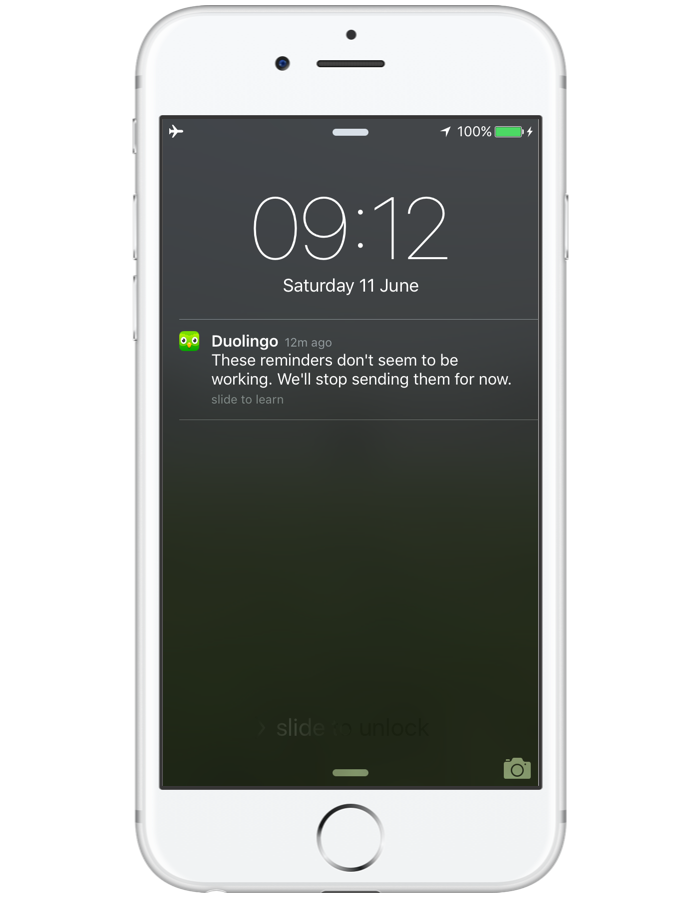
Memrise is also not too happy. A template message that, again, brings up the course navigation screen.

Both of these examples are cases with unsuccessful user reactivation campaigns. Notifications are not personalized or relevant. In addition, they are divorced from the experience of interacting with the product as a whole: a click takes you to the menu, instead of initiating some meaningful action.
I think this happens because designers do not perceive notifications as part of the application. Of course, in different companies it can be different, but they are usually referred to as “the sphere of marketing”. This is partly due to the framework for the automation of mobile marketing. Now, to create and launch push notifications, there is no need to touch the product at all. Marketers can do everything they need right from the dashboard.
Don't get me wrong: I appreciate the frameworks for automating mobile marketing, because they give much more flexibility and speed than hard code. Marketers can create notifications, conduct A / B testing, and launch new campaign iterations without the participation of engineers. And they do not have to wait for moderation on the market. It is very cool!
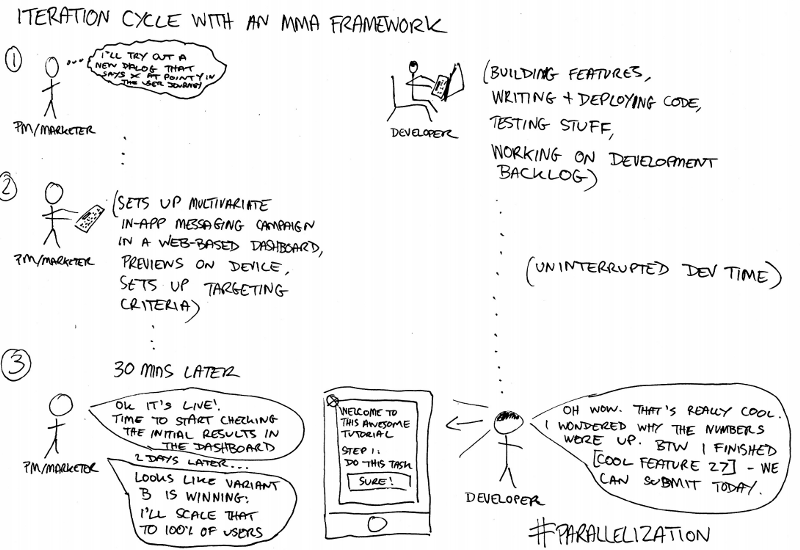
But at the same time, this means that marketing teams are responsible for these campaigns, who may work in isolation and practice an insufficiently holistic approach, building a strategy.
In the busuu team, user reactivation campaigns are conducted jointly by the marketing and development departments. We consider these campaigns as an integral part of the product and a key factor in developing a language learning habit.
At first we made the same mistakes as Duolingo with Memrise, but then we made push notifications rationally: personalized, relevant and useful. And we have statistics that confirms this.
Connect personal data
It so happened that we save information about each vocabulary unit that the user encountered during the course. And we thought: what if you ask, does a person remember how this or that word is translated?
We select a word from among those that the user has learned recently, and arrange a check - directly in the push-notification.
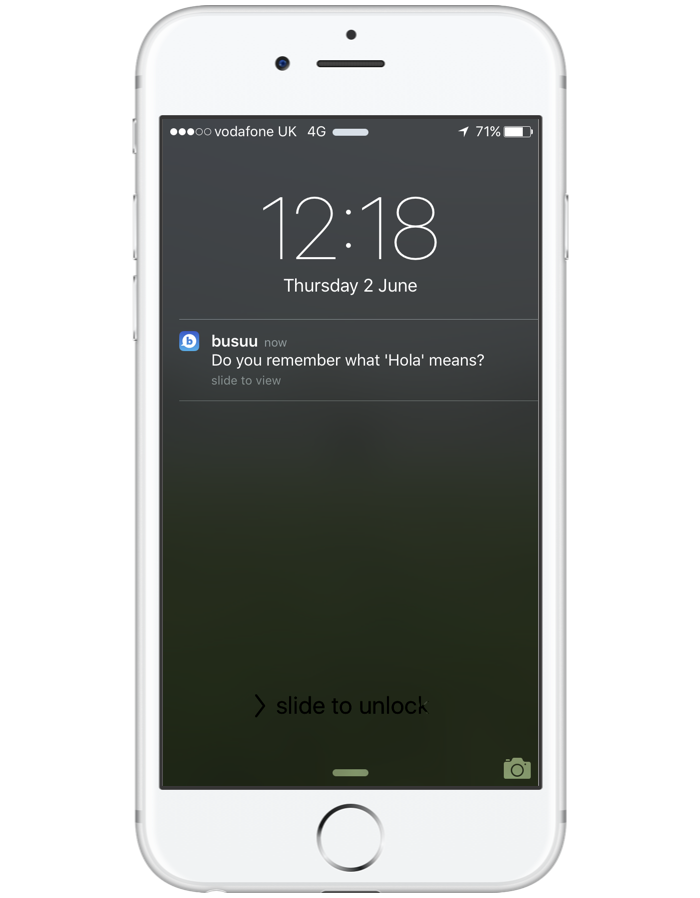
As Andrew Chen says:
Ask questions
To formulate the content of your notice as a question is a great way to increase its effectiveness.
Nir Eyal is also of the opinion that the trigger that creates intrigue is good :
We also never repeat, sending out words - this creates unpredictability and variability . “Variability arouses curiosity and makes you want to open a notification,” continues Nir Eyal.
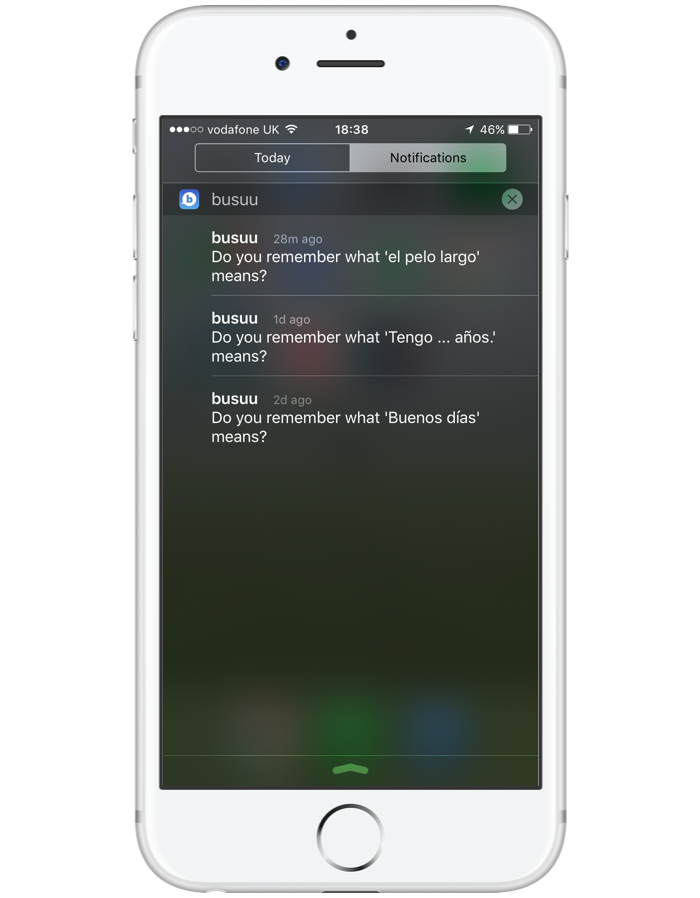
Connect with meaningful action
What happens if you click on the notification? Let us hint: you will not be transferred to the main menu or to the navigation panel, forcing you to guess what to do next.
Instead, the application will send you to the Vocabulary Simulator - a beautiful name for a test of knowledge of learned words.
And the most beautiful thing: the first question in the test will concern the very word from the notification you clicked on.
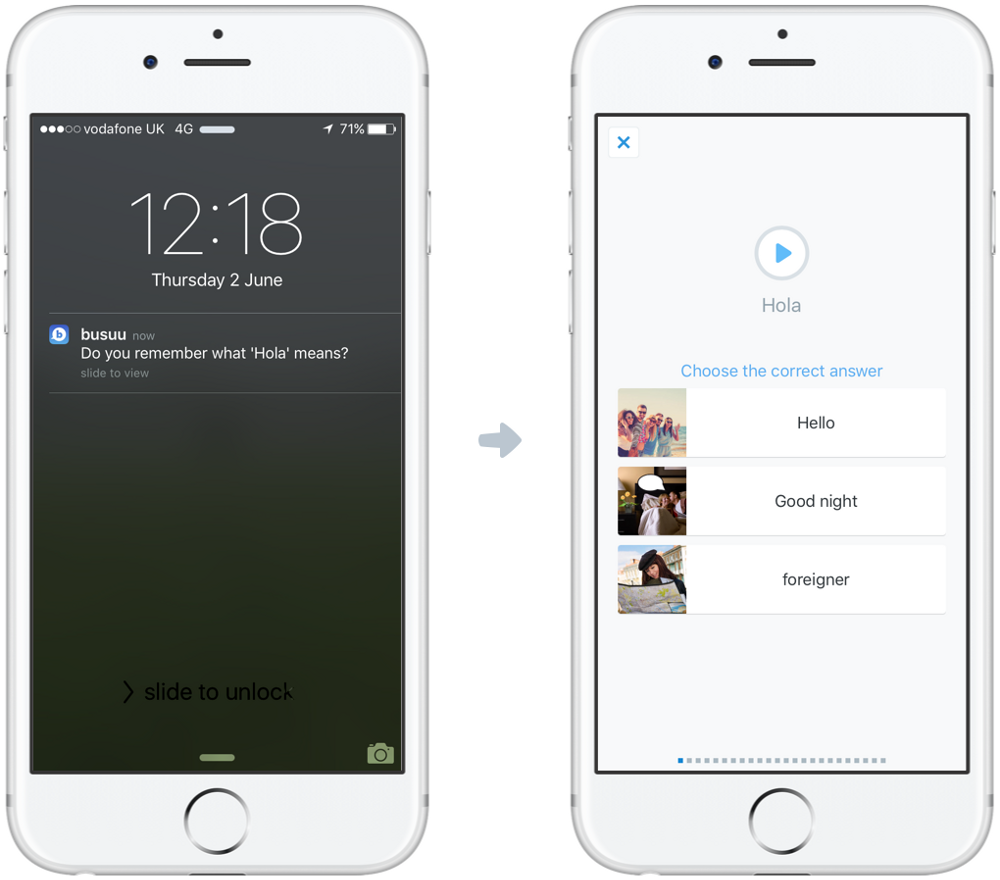
Here’s how it looks in motion:

Include reward and input
Those who are familiar with the works of Nir Eyal, probably noticed here " clue ".
First, we attract the user with a personalized push notification (external trigger) that is of interest (internal trigger).
Clicking on the notification, they answer the test question (action).
At the end of the test, a splash screen appears with a greeting and the number of points (reward).
Finally, after working with the accumulated vocabulary, they improved their long-term memory (contribution).

This ends the cycle to start again when the next notification comes (already with a different word).
Any strategy for implementing push notifications benefits from grocery thinking. Marketers and people involved in the development can combine their strengths to provide the user with a positive experience. So positive that it is perceived not as a campaign to reactivate the user, but as a truly useful feature.

However, the path to perfection is paved with procrastination and frustration. Many people quit what they started literally in a few days, when the first charge of motivation is exhausted. The famous effect of the “New Year's resolutions” is exactly what comes down to: buy a gym membership, go a couple of times and never return.
Regular training is the best way to learn anything. Therefore, we, as product designers, should help users develop the habit of exercising.
')
This is where push notifications come into play. When users lose interest, push notifications can serve as external triggers that help re-engage them in the process — provoking an action, thereby fixing the habit.
The problem is that most push campaigns to reactivate a user are no good. And we have put it mildly, in fact. Most of them simply remind of the existence of the application and do not bring any other good. These are just intrusive, desperate attempts to draw attention to themselves (“Is it time to do this”, “Come back?”). Worse, they find no connection with the product itself. If you click on them, you will simply be transferred to the main screen or navigation panel, no action will be performed. Inevitably you ask yourself the question: “Why then was it even calling me?”. Not surprisingly, 60% of users disable push notifications .
First, let's look at examples of push-notifications that do not do well with the task of engaging the user. Then I will tell you how we increased the percentage of open notifications three times, just by making them normal - useful, relevant, and reinforcing habits.
Useless notifications for reactivation
For you, probably, it is not news that notifications should be useful, relevant and timely . This is the mantra of mobile marketers. At the same time, oddly enough, few people take this into account, making up a campaign to reactivate users. For example, in our market segment — language learning applications — this principle is not taken into account at all.
Duolingo sends the same messages day after day. Faceless, patterned and even patronizing. And there's no sense in them: if you click on the notification, you will appear on the course navigation screen.

In the end, they send a final notice as the last attempt to get you back. Something like an obstinate former, yes?

Memrise is also not too happy. A template message that, again, brings up the course navigation screen.

Both of these examples are cases with unsuccessful user reactivation campaigns. Notifications are not personalized or relevant. In addition, they are divorced from the experience of interacting with the product as a whole: a click takes you to the menu, instead of initiating some meaningful action.
I think this happens because designers do not perceive notifications as part of the application. Of course, in different companies it can be different, but they are usually referred to as “the sphere of marketing”. This is partly due to the framework for the automation of mobile marketing. Now, to create and launch push notifications, there is no need to touch the product at all. Marketers can do everything they need right from the dashboard.
Don't get me wrong: I appreciate the frameworks for automating mobile marketing, because they give much more flexibility and speed than hard code. Marketers can create notifications, conduct A / B testing, and launch new campaign iterations without the participation of engineers. And they do not have to wait for moderation on the market. It is very cool!

But at the same time, this means that marketing teams are responsible for these campaigns, who may work in isolation and practice an insufficiently holistic approach, building a strategy.
Notifications are part of the product.
In the busuu team, user reactivation campaigns are conducted jointly by the marketing and development departments. We consider these campaigns as an integral part of the product and a key factor in developing a language learning habit.
At first we made the same mistakes as Duolingo with Memrise, but then we made push notifications rationally: personalized, relevant and useful. And we have statistics that confirms this.
- The percentage of open push notifications has tripled
- With a constant number of notifications sent out, earnings on Android increased more than tenfold, and on iOS threefold.
Connect personal data
It so happened that we save information about each vocabulary unit that the user encountered during the course. And we thought: what if you ask, does a person remember how this or that word is translated?
We select a word from among those that the user has learned recently, and arrange a check - directly in the push-notification.

As Andrew Chen says:
“Try to understand exactly what users value in your product, and customize the messages to their individual needs and interests. You will see: the number of interactions with notifications will immediately go up the hill, and users will turn into ardent supporters. ”
Ask questions
To formulate the content of your notice as a question is a great way to increase its effectiveness.
Nir Eyal is also of the opinion that the trigger that creates intrigue is good :
“A bit of curiosity can do a lot to push the user to perform a certain target action.
Triggers best encourage people to navigate the screen and find out more when the notification contains a mystery: what will they find inside?
Timehop, for example, sends impudent notifications with the text: “Is it crazy, is it really you?”, Thereby pushing people into the app. To see the photo in question, simply hold the screen. It also helps that Timehop messages are written in a light, funny style that makes them stand out. ”
We also never repeat, sending out words - this creates unpredictability and variability . “Variability arouses curiosity and makes you want to open a notification,” continues Nir Eyal.

Connect with meaningful action
What happens if you click on the notification? Let us hint: you will not be transferred to the main menu or to the navigation panel, forcing you to guess what to do next.
Instead, the application will send you to the Vocabulary Simulator - a beautiful name for a test of knowledge of learned words.
And the most beautiful thing: the first question in the test will concern the very word from the notification you clicked on.

Here’s how it looks in motion:

Include reward and input
Those who are familiar with the works of Nir Eyal, probably noticed here " clue ".
First, we attract the user with a personalized push notification (external trigger) that is of interest (internal trigger).
Clicking on the notification, they answer the test question (action).
At the end of the test, a splash screen appears with a greeting and the number of points (reward).
Finally, after working with the accumulated vocabulary, they improved their long-term memory (contribution).

This ends the cycle to start again when the next notification comes (already with a different word).
Conclusion
Any strategy for implementing push notifications benefits from grocery thinking. Marketers and people involved in the development can combine their strengths to provide the user with a positive experience. So positive that it is perceived not as a campaign to reactivate the user, but as a truly useful feature.
Source: https://habr.com/ru/post/331408/
All Articles